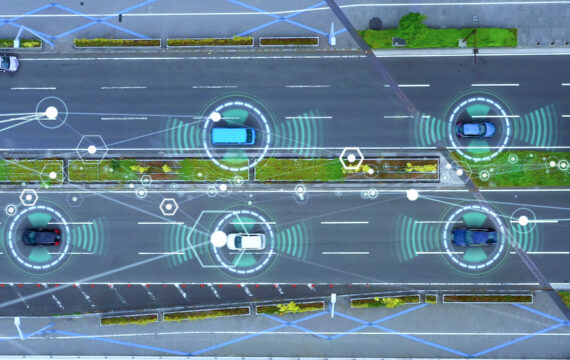In the last decade, the self-driving vehicle industry has made huge strides toward a fully autonomous future. Today, self-driving cars can effectively communicate with people, safely drive under heavy weather conditions, and smoothly navigate the most complex city environments. Why then is full automation still far from the top consumer request? The truth is simple: people don’t want full automation because they have concerns about autonomous cars safety.
Make no mistake about it: failures speak louder than successes. You’ve probably heard of Tesla’s fatal autopilot crash and the self-driving Uber vehicle that killed a pedestrian in Arizona. This kind of news contributes to public opinion more than the breakthroughs in new safety features of autonomous cars.
The result? Almost 80% of Americans say they would be afraid or very afraid of riding in an autonomous vehicle. It’s time to find out what the safety features in autonomous cars are that can make the mass use of self-driving vehicles possible.
Almost 80% of Americans would be afraid or very afraid of riding in an autonomous vehicle.
Customer safety concerns, or why autonomous cars safety is the top request
Accidents involving self-driving cars are definitely the major factor undermining trust between humans and fully autonomous vehicles. As a result, less than 50% of US consumers are interested in fully automated technology.
But the truth is that self-driving vehicles may substantially decrease the number of fatal accidents on the roads. By simply removing the risks of driver fatigue and alcohol impairment, fatal accidents in the US would be reduced by 45.5%.
Consumer opinion on fully self-driving vehicles

Source: 2018 Deloitte Global Automotive Consumer Study
It might seem that 45% of consumers do not believe in autonomous vehicles safety. It represents a great challenge for the automotive industry. Yet compared to the 72% who believed this the previous year, it seems that manufacturers and developers have taken a huge step in building trust between consumers and self-driving cars. Successful on-road tests are definitely the most powerful tool for automotive market players to show that full automation can also be safe.
By removing the risks of driver fatigue and alcohol impairment, fatal accidents in the US could be reduced by 45.5%.
Factors making consumers feel better about riding in a fully autonomous car

Source: 2018 Deloitte Global Automotive Consumer Study
Autonomous car safety features that can save millions of lives
It’s no coincidence that autonomous car safety features are more important to consumers than comfort, connectivity, and fuel efficiency. The percentage of US consumers who say they wouldn’t be willing to pay more for safety features in autonomous cars is substantially lower than the percentages unwilling to pay for other categories of upgrades. Needless to say, safety-related technology is what can help you win customer loyalty.
US consumers not willing to pay for extra vehicle features

Source: Deloitte Review 2017: The race to autonomous driving
Mass adoption of self-driving cars isn’t only a matter of building trust between humans and technology or improving road safety statistics. Autonomous vehicles can save a significant amount of time that people can instead spend on fun, relaxation, or business. But first, self-driving cars need to prove that they’re safe. Here are the top five autonomous car safety features to ensure you’re still alive after the ride.
Emergency braking is essential to avoid collisions with pedestrians and other vehicles
As a key element underlying the autonomous cars safety, the emergency braking system aims to prevent road accidents and crashes involving moving and stable objects. The process of emergency braking can be divided into several stages. The first is road observation, which is usually handled by a combination of cameras and radar or Lidar sensors. Based on data from these devices, the time to objects is calculated. If a threat is detected, audiovisual alerts are sent to the driver. In case no steps are taken to avoid the threat, the brakes are activated automatically.
The process of emergency braking involves road observation, time-to-object calculation, and alert system activation.
The timing of a car reaction on the road events

Depending on the level of automation, three major types of automatic emergency braking (AEB) systems are defined. The first is a forward collision warning system, which only detects threats and alerts the driver and passengers. The second type of AEB system is dynamic brake support, which not only alerts the driver but also supplements the driver’s braking. The last and safest type of AEB system is a crash imminent braking system, which can stop the car even if the driver fails to respond to alerts.
Drive smoothly and control speed with adaptive cruise control
Adaptive cruise control (ACC) is a complex system that enables a vehicle to slow down and accelerate in order to keep pace with objects moving ahead. With an ACC, before the start of a trip the driver sets the maximum speed as well as driving preferences regarding in-lane movement. When the driver activates the ACC system, it instructs the car to stay 2 to 4 seconds behind vehicles ahead.
How does adaptive cruise control act?

- Vehicle cruise control set at 70mph
- Radar detects a slower vehicle ahead, reduces speed to return the vehicle to a present following distance
- Cruise control adjusts to the lead vehicle’s speed and resets to the original speed if traffic clears
Adaptive cruise control can’t work effectively without advanced sensors including rearview cameras, radar, and Lidar. ACC is often paired with an emergency braking system to ensure safety in case objects ahead change trajectory unexpectedly.
Vehicle-to-vehicle (V2V) communication as a means of safety
Communication between vehicles plays a crucial role in making self-driving technology genuinely safe. To drive safely, an autonomous car needs to have access to accurate and current information on the weather, repair work, and other factors influencing traffic. Cross-car communication is usually based on cloud information technologies that enable cars to process and receive data about the surroundings that makes the crucial features of self-driving cars work.

V2V communication may involve sharing real-time and historical sensor data, multilayer maps, and predictive machine learning data. For this purpose, comprehensive cloud-based platforms are being developed with the cooperation of T1 vendors and software specialists. Over-the-air map updates that adjust atypical map formats to meet the Navigation Data Standard are one example of how cross-car communication. This type makes driving safe and feasible by uploading data on the surroundings from cars ahead to help other cars prepare for further obstacles.
Sensor fusion to ensure autonomous cars see the world and don’t hit the wall
An Advanced Driver Assistance System (ADAS) is an integral element of autonomous transportation. The work of ADAS is based on information received and processed with the help of different types of self-driving car sensors. These include rearview cameras, radar, and Lidar. Each type of sensor is by itself not enough to guarantee autonomous vehicles safety. Therefore, a mix of different technologies is commonly applied.
A rearview camera with ultrasonic or radar sensors enables a car to identify objects within 150 meters regardless of weather conditions.

Examples of typical sensor fusion solutions include a combination of a front camera with a multimode front radar or a combination of a rearview camera with ultrasonic or radar sensors. Radar sensors enables a vehicle to identify both moving and stable objects within 150 meters even under heavy weather conditions. Complex integrating platforms like Nvidia’s Drive PX are subsequently used to process the data received via sensor fusion.
How can lane keeping increase autonomous cars safety and help avoid crashes?
Lane detection and tracking algorithms are an integral element underlying advanced self-driving technology. Lane keeping assist can be divided into three stages: pre-processing, detection, and tracking. The first stage is based on path planning mechanisms that elaborate the route in compliance with set parameters. Then the real-time data received via sensors is processed to detect and keep the safest path. In case the car is about to cross the lane spontaneously, the lane keeping assist activates immediately.
Lane keeping assist

- Vehicle in lane
- Driver is alerted if turn signal is not used
- System gently steers vehicle back into lane if driver doesn’t respond
Many auto industry players manufacture steering assist technologies to supplement their lane keeping systems. High-end luxury car series including the BMW 7 Series, the Mercedes-Benz S-Class, and the Volvo S90 are already equipped with sophisticated steering assist technologies. In short, top-notch autonomous driving features are increasingly in demand among all groups of customers.
Autonomous vehicles safety concerns remain the most powerful factor undermining the mass use of autonomous vehicles. Regular news reports on self-driving car failures reinforce customers’ fears and biases. Yet original equipment manufacturers, tech companies, and software vendors have already taken enormous steps toward safe, secure, and full automation technology. Emergency braking, adaptive cruise control, cross-car communication, sensor fusion, and lane keeping assist are the most convincing arguments that safe driverless cars are possible. Implementing these safety features in autonomous cars is the key to increasing trust and winning customer loyalty.
Intellias’ experts know how to help your company benefit from in-demand safe autonomous driving solutions. Contact us to bring your boldest business ideas to life.


